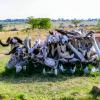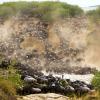Best time to visit Tanzania
The best time to visit Tanzania is during the Dry season, which lasts from June to October and is ideal for wildlife viewing. This is also the greatest time to watch the wildebeest migration in Serengeti National Park. The best time to watch wildebeest calving is between January and February.
Also The best time to visit Tanzania depends on the specific experiences you seek, as the country has distinct seasons that influence wildlife viewing, weather, and other factors.
Here are some considerations for different times of the year:
Dry Season (June to October)
-
Wildlife Viewing: This is the peak of the dry season, and wildlife congregates around water sources, making it an excellent time for safari. The Great Migration is often in the Serengeti during these months.
-
Weather: Days are usually sunny with cooler temperatures. This is a popular time for climbing Mount Kilimanjaro.
Serengeti National Park: Witness the iconic Great Migration as millions of wildebeest and zebras move across the plains in search of water and food. Predators, including lions and cheetahs, are also highly active during this time.
Ngorongoro Crater: Animals gather around the crater floor's water sources, providing exceptional opportunities for wildlife viewing.
Tarangire National Park: Known for its large elephant herds, the park boasts diverse wildlife congregating around the Tarangire River.
Short Rainy Season (November to December)
-
Wildlife Viewing: While still a good time for safari, the landscapes are lush, and some animals disperse as water becomes more available.
-
Weather: Short afternoon rains may occur, but the days are generally pleasant.
Long Rainy Season (March to May)
-
Wildlife Viewing: The lush greenery and baby animals make it a unique time for safari, but some areas may be challenging to access due to muddy conditions.
-
Weather: This is the main rainy season, with heavy rainfall and high humidity. Some lodges and camps may close during this time.
Shoulder Seasons (January to February and June to July)
-
Wildlife Viewing: These months mark the transition between rainy and dry seasons, offering a mix of green landscapes and good wildlife sightings.
Serengeti National Park: This is the calving season for wildebeest, and the landscapes are vibrant and green. It's a unique time to see baby animals.
Manyara and Selous: These parks showcase lush greenery, and since they are less visited during the rainy season, you may experience a more exclusive safari.
-
Weather: January to February is a drier period, while June to July sees the start of the dry season.
Zanzibar and Coastal Areas
-
Dry Season (June to October): Ideal for beach vacations and water activities with sunny and dry weather.
-
Short Rainy Season (November to December): Occasional short rains may interrupt beach plans.
-
Long Rainy Season (March to May): Heavier rainfall, and some accommodations may close during this time.
Overall, the dry season, particularly from June to October, is often considered the best time for a safari in Tanzania. However, the country's diverse attractions mean that there is no one-size-fits-all answer, and the ideal time to visit may vary based on personal preferences and the specific regions you plan to explore.




